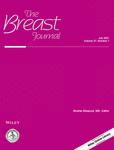Can one stop nucleic acid sampling (OSNA) predict nodal positivity following neoadjuvant chemotherapy? A prospective cohort study of 293 patients
Abstract
Until recently, axillary node clearance had long been the standard of care in patients with axillary node-positive disease. One stop nucleic acid sampling (OSNA) has been used to guide intraoperative decision-making regarding suitability for axillary node clearance (ANC). The aim of this study is to evaluate the use of OSNA following neoadjuvant chemotherapy (NACT) and whether it can predict lymph node burden in ANC. A single center, prospective cohort study was performed on 297 patients having OSNA between 2016 and 2019. Patients were sub-classified according to node positivity at diagnosis and those treated with NACT and outcomes included copy number and lymph node harvest. Axillary complete pathological response was observed in 24/36 patients (67%) following NACT. 14/16 patients (87%) having axillary node clearance had axillary node disease limited to 4 nodes. OSNA copy numbers were significantly higher in patients showing disease progression following NACT. Overall, 73% of patients with lymph node positivity at diagnosis could be successfully treated with a combination of NACT and lymph node excision of four nodes. De-escalating axillary surgical treatment to resection of four nodes following NACT may be effective in balancing oncological resection and limiting treatment morbidity. ONSA can correctly identify patients experiencing disease progression who would benefit from traditional three-level ANC.
CONFLICT OF INTEREST
There are no competing/conflicts of interests.




